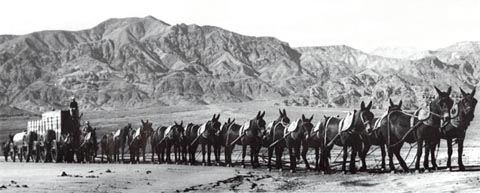|
What to look at
Death Valley has so many interesting geologic features
it's hard to know where to start and what to include. It would be impossible
to cover all of the features of the valley comprehensively in this article,
so instead I've selected a few of what I believe are the more interesting
features. Starting at the lowest point in the park (and North America),
we'll work our way up. Along the journey, we'll examine salt deposits, sand
dunes, alluvial fans, the unique Ubehebe Crater, the famed Racetrack Playa,
and finally the larger forces that have created the massive peaks and the
valley itself.
|
|
The lowest points
From a distance, the floor of Death Valley seems quite
uniform and flat. The salt pan, one of the world's largest, makes up a large
portion of the valley floor. It is comprised of residue left over from the
evaporation of water trapped in the valley. Some of these deposits have
formed recently, but most are leftovers from the ancient Lake Manly. These
deposits are nearly 9,000 feet deep!
At the lowest point, 282 feet below sea level, you'll find
Badwater, a nasty salty pond, lifeless except for microscopic plant life.
Surrounding Badwater, other salt deposits, such as the Devil's Golf Course,
have rough features where brief rainstorms have carved through the existing
salt deposits.
|

|
Badwater, the lowest point in North America.
Click on the photo to view larger version. Photo by Benjamin Mendelsohn.
|

|
Allen Glazner explains how the salt
pan was formed and what it is made up of.
|

|
|

|
The Devil's Golf Course. Click on the photo
to view larger version. Photo by Benjamin Mendelsohn.
|
|
Table salt is what most people think of when they think of
salt, and sodium chloride (NaCl) can be found in the salt pan. There are
also other compounds with residues rich in sulfates and carbonates. Each
of these compounds has a different solubility and this affects the order
in which each is deposited during evaporation. Carbonates are deposited
first, followed by sulfates, and finally by the most soluble compound, sodium
chloride.
|
|
Some of these compounds are useful and valuable. Borate
minerals (such as ulexite & borax) are used in the manufacture of a
variety of products, including soaps, pharmaceuticals, herbicides, and even
rocket fuel. Part of Death Valley's history includes Eagle Borax Works--a
borax mine founded in 1881. The famed 20-mule teams were charged with the
task of hauling borax 165 miles to the railhead at Mojave, California. While
most mining in Death Valley proper has been curtailed, borates continue
to be mined throughout the region.

|
A 20-mule team hauling borax out of the valley.
Photo provided by the National Park Service.
|
|
|